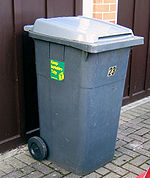- Bin bug
-
The term "bin bug" was coined in August 2006 by the British media to refer to the use of Radio Frequency Identification (RFID) chips by some local councils to monitor the amount of domestic waste created by each household. If the pilot schemes are successful it is expected that most British cities will introduce the system in the next two years.[1][2] Three local councils in England and five Ulster councils have been trialling the scheme.[3]
The system works by having a unique RFID chip for each household's non-recycling wheelie bin (such households have two bins: one for general waste and one recycling bin). The chip is scanned by the dustbin lorry and, as it lifts the bin, records the weight of the contents. This is then stored in a central database that monitors the non-recycled waste output of each household.[1][4]
While some councils informed the householders of their intentions to monitor their waste output many others did not.[1][5] Worcester City Council, for example, detailed their plans through local newspaper Worcester News in August 2005.[6] Aberdeen City Council kept the scheme quiet until a local newspaper ran the story; the council declared no intention to operate or bring the system online but did not rule out future use.[7] Some councillors said that the purpose of the "bin bugs" was to settle disputes about the ownership of the bins, but others mentioned that the system is a trial and means that they are more prepared should the government introduce a household waste tax. The tax would be in the form of a charge for households that exceed set limits of non-recycled waste.[1][5][8] With recycling in the UK amongst the lowest percentage in Europe at 18%, a new tax scheme would have the intention of encouraging domestic recycling and meeting European landfill reduction targets.[2]
Each RFID chip costs around £2, with each scanning system costing around £15,000. The Local Government Association (LGA) provided £5 million to councils to fund 40 pilot schemes.[2] They are supplied by two rival German companies: Sulo and Deister Electronic.[1] Some suggest that people who removed the chip might not have their bin emptied.[5]
The motivation behind the RFID chips are to monitor the production of landfill waste so that councils can comply with the European Landfill Directive 1999/31/EC. "[1]"
Removing the bug
The RFID tag is located in a recess under the front lip of the bin, either as a self contained unit or behind a plastic cap [9][10][dead link][11][dead link].
There is some debate as to the legality of removing the RFID chip.[12]
References
- ^ a b c d e thisislondon.co.uk. 26 August 2006. "Germans plant bugs in our wheelie bins". Accessed 1 September 2006.
- ^ a b c BBC News. 27 August 2006. "Bugged bins to promote recycling". Accessed 5 September 2006.
- ^ McBride, Sam. Belfast Telegraph. "Secret chip that checks what you put in your bin". Accessed 5 September 2006.
- ^ Mirror.co.uk. 28 August 2006. s/tm_objectid=17638188&method=full&siteid=94762&headline=how-the-bin-bug-works--name_page.html How the bin bug works". Accessed 1 September 2006.
- ^ a b c 28 August 2006. "Kennet Bin Bug Secrecy — Council leader "not told of true purpose"". Accessed 1 September 2006.
- ^ 31 August 2006. Berrow's Worcester Journal
- ^ 31 August 2006 http://www.thisisnorthscotland.co.uk/displayNode.jsp?nodeId=149235&command=displayContent&sourceNode=149218&contentPK=15298408 Outrage over secret bugs in rubbish bins Accessed 31 August 2006.
- ^ Leyden, John. The Register. 29 August 2006. "Wheelie bin bugging foreshadows 'rubbish tax'". Accessed 1 September 2006.
- ^ Is your bin bugged?
- ^ Removing the Bin Bug
- ^ Another day...
- ^ The Great Bin Bug Revolt
Wikimedia Foundation. 2010.

